Mexican warriors, eagles and jaguar warriors against the Spanish conquistadors. Aztec campaign (part five)
(Joel 3: 9)
Well, now, when we met with written sources of information (except for artifacts in museums) about the life of Mesoamerican Indians, we can continue our story about how they fought. And we begin again with doubts about the number of Indian troops. Immediately make a reservation that - yes - many scholars doubt that the Aztec troops were so numerous, as it is written in the Spanish colonial chronicles. Nevertheless, it is impossible not to admit that the estimate of their number given by them is quite plausible and this is why: it was the Aztecs who could create supplies of provisions and equipment in such quantities that other civilizations of the New World never dreamed of. And we know about this again from the codes, in which the volumes of tribute to the Aztecs from the conquered peoples are carefully recorded. There is another reason explaining the population of the Aztec state. This is a high yield of maize - their main grain crop. True source, wild maize, had too small grains, and this prevented him from becoming the main food culture of the Indians. But when they fattened it, the maize spread very widely and eventually became available to all pre-Columbian cultures, which replaced hunting and gathering for agriculture and, accordingly, sedentary life. The Aztecs invented many ways of cultivating the land: they hollowed out, for example, terraces on the slopes of mountains, and flooded them with canals, and even grew plants on reed rafts that swam across the Texcoco lake. Maize was the same for them as wheat and rye for Europeans and rice for the inhabitants of Asia. It was thanks to maize, as well as to beans and zucchini, that Mesoamericans received food rich in proteins, which, when consumed, practically did not need meat.
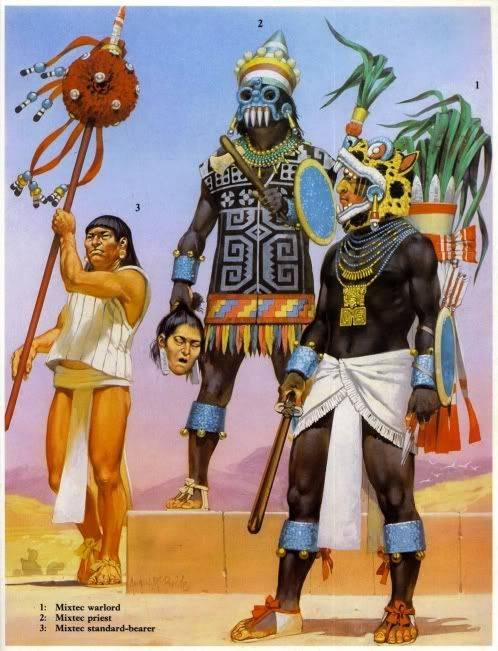
Fig. Angus McBride: Mixteck Standard Bear (3), Priest (2), War Leader (1). The image of the military leader is based on the figure in Codex Nuttal, the priest is Codex Bodley.
But with the meat, the Indians had problems. Of all the pet animals, the Aztec were only dogs and turkeys. Of course, they hunted deer and bakers (wild pigs). It is known that in some places deer Indians even milked. But this was not enough to feed everyone with meat. At the same time, the division of labor was as follows: women worked in the gardens and took care of domestic animals, men worked in the fields. And nowhere else in the world did plants put so much time and effort into plant domestication, so we should be thankful to the ancient Aztecs for giving us corn, beans, squash, tomatoes and much more. Even cotton and that Aztec grew already painted in different colors!
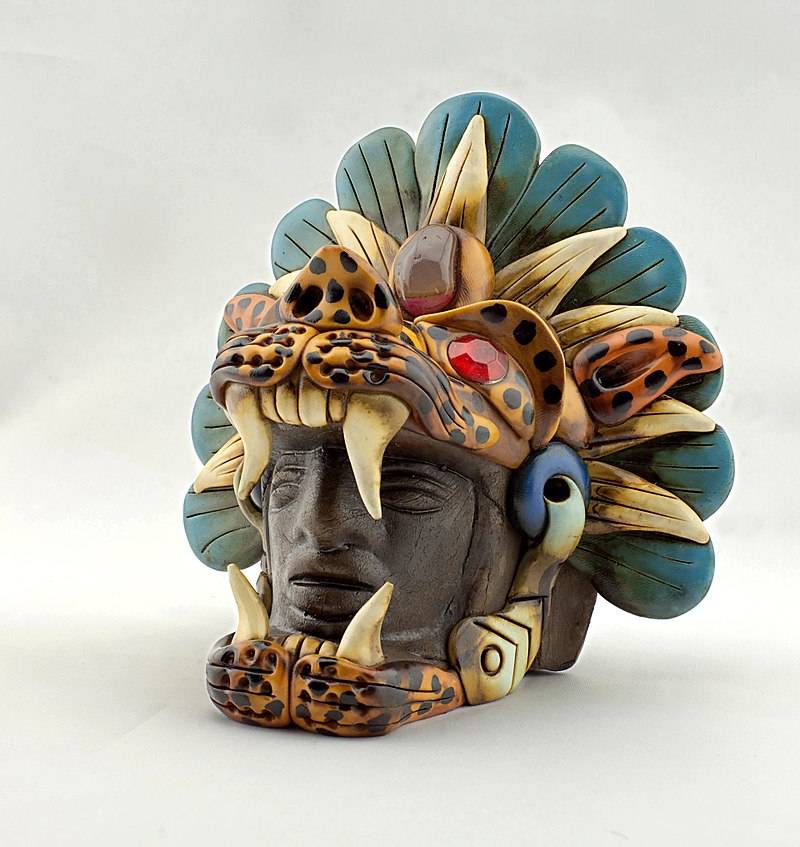
The head of a jaguar warrior.
As for the Aztec army, it was supplied from two sources: the actual stocks of the kalpilli and those stocks that, under their instructions, were created by the conquered peoples and states along the path of their army. Most of the food that the warrior took on the campaign was prepared by his family or received from market traders on account of the tax. Such an approach was a guarantee that the damage to the economy of the subordinate states would not be very large. The Aztecs wisely tried not to harm the crops and not needlessly kill those who grew it. All people who were not warriors were obliged to work on the communal fields in their calpelli. In October, the harvest was ripening, and the maize was then harvested, dried, and ground into flour in home mills. Then water was added to the grinded flour, and six-pointed flat cakes, baked on hot ceramic discs, were molded from the resulting dough. On the eve of the beginning of the war season, in November, the wives, mothers and sisters of Aztec warriors cooked a huge amount of such flat cakes, dried beans, pepper and other seasonings, and also dried the meat - venison, bakers meat, cooked smoked turkey meat. In the campaign, all this was carried not by a warrior, he had something to carry - his weapon, and the teenager from telpochkali who was accompanying him, appointed to be a porter for the time of the march. Then followed a four-day fast and prayers to the gods for the granting of victory. The warrior's father made a penitential sacrifice with his blood all these days, piercing the cactus spines with his tongue, ears, hands and feet, so that the grateful gods would return his son intact and unharmed in the spring. The commander of the detachment, who, after all, had not known women, including his own wife, for all that time in this position.
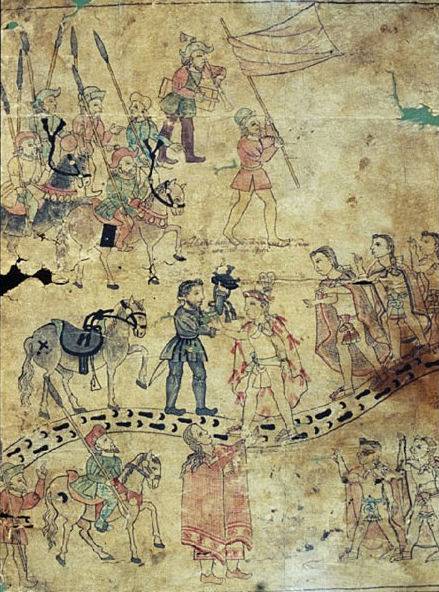
Aztec ruler Hicotencatl meets Cortes. "History Tlashkaly.
In the first long campaigns, the troops of the Aztec Triple Alliance between the city-states of Tenochtitlan, Texcoco, and Tlakopan relied on the Tlamemek porters who dragged most of the food and equipment after the warriors. Thus, on the march to Koishtlauac in 1458, their army was accompanied by 100 000 porters, each carrying at least 50 pounds (approx. 23 kg) of only one equipment. Later, the empire demanded that the conquered tribes and cities create permanent repositories for them, in cases where they went through their territories. Therefore, in the XVI century. the Aztecs had practically no problems in order to feed an army of tens of thousands of warriors. And the fact that this is not an exaggeration again, the codes say, calling shikuipilli as a mobilization unit (another name of the Aztecs) shikuipilli - the corps 8000 is a man who exhibited Tenochtitlan from each 20. So that the daily life of the city is not disturbed, the troops marched not at one time, but for several days, detachment after detachment. During the day, the army ran from 10 to 20 miles (16-32 km), which depended on the location of the enemy and the desirability of a surprise attack. Considering the fact that the Tenochtitlan army was then connected to the Allied troops of approximately equal size, it was necessary to choose at least three to four routes of movement. At the same time, there was a rule, also known in Europe: to move apart, and beat the enemy together! That is, the Aztec commanders had maps of the area and could accurately calculate who, where and at what time will appear. It was believed that a corps of such numbers has enough power to cope with any encountered enemy that will stand in his way to the junction. If the forces turned out to be unequal, the scout could always send messengers for help, and then within a few hours other parts of the army would approach the battlefield and could attack the enemy from the rear or flank. Since the Aztec army consisted of lightly armed infantry, the speed of movement of any unit was the same, so it was very easy to calculate the time for the reinforcements approach.
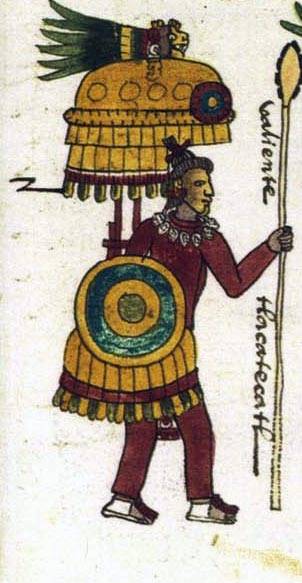
"Captain" with a spear, the tip of which is seated obsidian blades. Codex Mendoza.
Coordination of such large units was directly related to the training of their “officers”. The commander-in-chief was considered Way tlatoani, who often himself participated in the battle, like many of the commanders of the Ancient World in Europe and Asia. The second most important was the siuacoatl (literally - "the woman-snake") - a high-level priest, who traditionally bore the name of the very goddess, the cult of which he headed. The first Siuacoatl was Montezuma’s half-brother, Tlacaelel, from whom she passed on to his son and grandson. Sihuacoatl was in charge of managing Tenochtitlan in the absence of the emperor, but he could also be commander in chief. During the war, the supreme council of four commanders was responsible for the army. Each of them was engaged in his own business - supply organization, transition planning, strategy and direct battle management. Then came the "officers", who can be equated to our colonels, majors, captains, and so on, who carried out the orders of the Supreme Council. The highest rank that a commoner could have achieved was the quaupilli - this is something like a commander with a title reward.
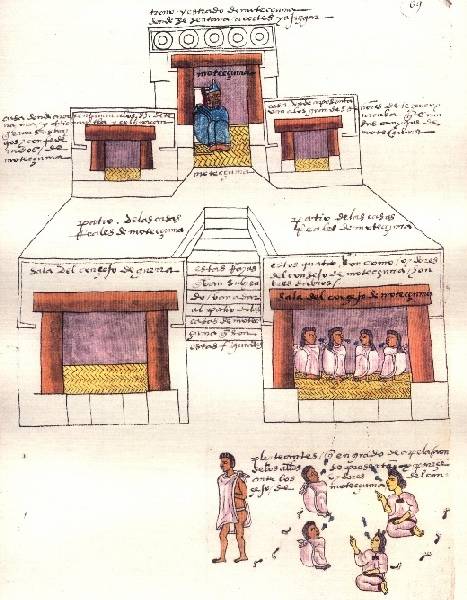
Palace of Montezuma Shokoyokin. "Codex Mendoza"
When the supply lines directly from Tenochtitlan were stretched for a long distance, the army had to rely on warehouses arranged by dependent city-states along the entire indicated route. But the uniqueness of the Aztec empire was precisely in that it did not try to control vast territories, but preferred strategic points along important trade routes. Noble foreigners, appointed by the Aztecs to high positions, had enormous power in their lands, but at the same time they were indebted to the empire, which supported their power at the cost of an exorbitant burden for their subjects. Therefore, the Aztecs considered it necessary to assign tax collectors to the vassal kingdoms accompanied by the Aztec troops stationed there. After the conquest of Koishtlauaki, the empire developed several ways to destroy the confederations of the city-states of eastern Nahua, Mixtecs and Zapotecs. Initially, these methods were extremely ruthless. Under Montezuma I, the inhabitants of the conquered lands were either sold to slavery without exception, or they were cruelly executed on the square in front of the Great Temple in Tenochtitlan. The loss of workers was compensated for by the Aztec migrants, who installed the control system according to local designs. Particularly indicative is the example of Uashyakaka (present-day Oaxaca, the main city of the Mexican state of the same name), where even its own ruler was appointed.
In other cases, the Aztecs subdued local political systems, playing on discord among the local nobility. The Aztecs skillfully used the weaknesses of their neighbors when choosing a contender for power. The pictorial testimonies from Koishtlauaki, for example, show that after Atonal’s death, the heir was chosen from a rival dynasty, while one of Atonal’s wives was appointed ... a tax collector. In other cases, those of the applicants who, in despair, were ready to deal with the devil himself, invited the Aztecs themselves to solve the matter in their favor with their help. The destruction of political foundations could go and more insidious ways. Among eastern Nahua, Mixtecs, Zapotecs and their allies, marriages in royal families were often planned for many generations to come. When the Aztecs subdued one of the members of this confederation, Way tlatoani or someone from the highest nobility could demand a wife from a local ruling family. This not only connected the vanquished with the Aztec ruling house, but also violated the whole system of predetermined marriages. Whatever strategy the conquerors chose, they strove to constantly increase the network of subordinate states that could supply the Aztec army if it were necessary for them to pass through their territory.
The Spaniards and their Tlashkoltek allies (among them the heron warriors are an elite warrior squad, since the heron was one of the patrons of Tlashkala). "The Story of Tlashkaly". Not even such a trifle is forgotten as a brand on horse groats!
In the methods of warfare among the Aztecs not the last place was occupied by ... witchcraft! And they were engaged in it quite seriously and, probably, in all these magic rituals and sacrifices that took place before the battle and called the wrath of the gods on the enemy, very many believed, and this was encouraging them! However, at the same time, plants like oleander were burned, which gave poisonous smoke, causing nausea, pain and even death - if the wind carried it in the right direction. A slower, but no less effective way was to mix the poison in food and water - especially when the enemy was ready to withstand the siege. If necessary, even palace couriers could become murderers - when it was necessary to resolve the conflict between representatives of one ruling house and another.
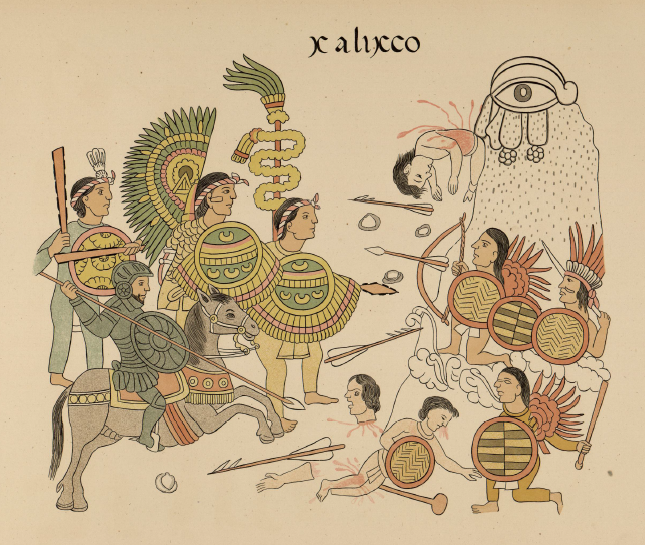
This image clearly shows that the Indians use two types of arrows: with wide tips and narrow, serrated. "The Story of Tlashkaly".
To be continued ...
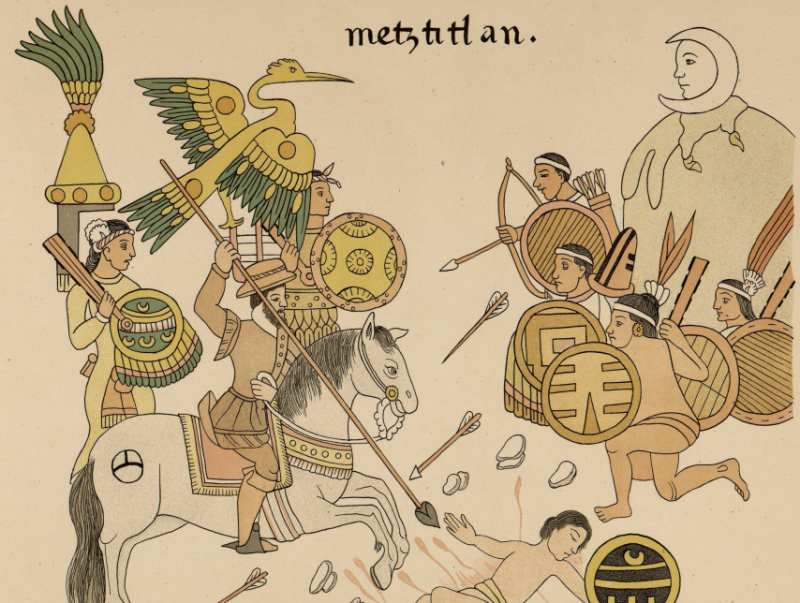
Information